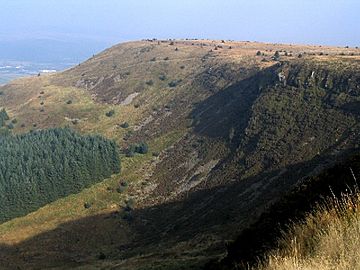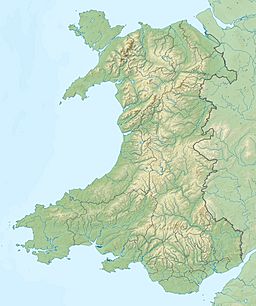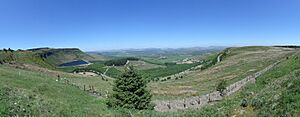Craig y Llyn facts for kids
- For the subsidiary summit of Cadair Idris see Craig-y-llyn.
Quick facts for kids Craig y Llyn |
|
|---|---|

The west face of Craig y Llyn
|
|
| Highest point | |
| Elevation | 600 m (2,000 ft) |
| Prominence | 392 m (1,286 ft) |
| Listing | Marilyn, council top |
| Naming | |
| English translation | cliff of the lake |
| Language of name | Welsh |
| Geography | |
| OS grid | SN906031 |
| Topo map | OS Landranger 170 |
Craig y Llyn is a mountain in South Wales. Its name means 'rock/cliff of the lake' in Welsh. It stands south of the village of Rhigos and is the highest point in the historic county of Glamorgan. It's also the highest peak in the South Wales Valleys.
Exploring Craig y Llyn
The very top of Craig y Llyn is in the area of Neath Port Talbot. Its eastern side is in Rhondda Cynon Taf. The border between these two areas runs about 200 meters east of the summit. The mountain gets its name from the steep sandstone cliffs. These cliffs drop down to two lakes on the northern side.
Most of the hill is covered by forestry. However, the steep northern and northeastern faces are open. At the very top, you'll find a trig point, which is a marker used for surveying. Many footpaths go near the summit, including the Coed Morgannwg Way. Craig y Llyn is often called the Rhigos Mountain. This is because of the village of Rhigos, which is located on its northern side.
A Special Place for Nature
Part of Craig y Llyn has been named a Site of Special Scientific Interest (SSSI). This means it's a very important place for nature. The Countryside Council for Wales says this area is special for two main reasons:
- Unique Lakes: The lakes here have very clear water with low nutrients. This allows special water plants to grow. Some of these plants are not found anywhere else further south in the UK!
- Dry Heathland: On the slopes above the lakes, you'll find dry heath. This is a type of habitat with small shrubs and grasses.
The SSSI is also important for a specific plant called the water lobelia.
How the Mountain Was Formed
Craig y Llyn is made up of many layers of sandstone and mudstone. These rocks are part of what geologists call the South Wales Coal Measures. The flat top of the mountain is made from a type of rock called Pennant Sandstone.
The two bowl-shaped valleys on the northern side of the mountain are called cwms. These cwms hold two lakes, Llyn Fach and Llyn Fawr. These valleys and lakes were carved out by glaciers long ago. In fact, these two lakes are the southernmost glacial tarns (lakes formed in glacial hollows) found in Great Britain! There's also a large mass of rock that has slipped down near the western end of Llyn Fawr.



